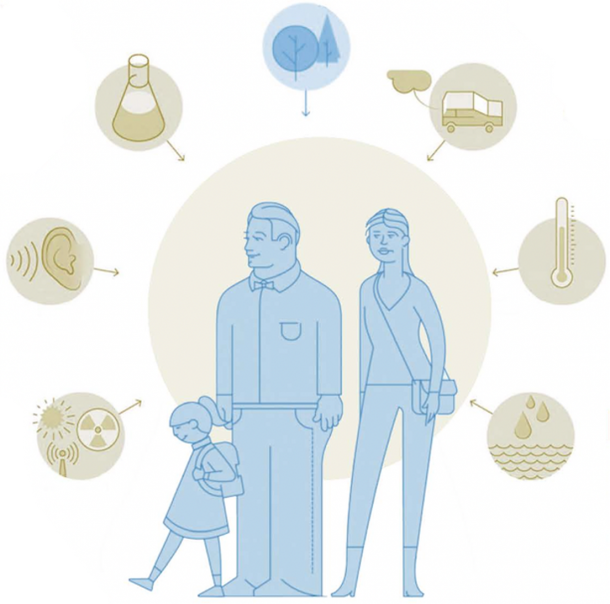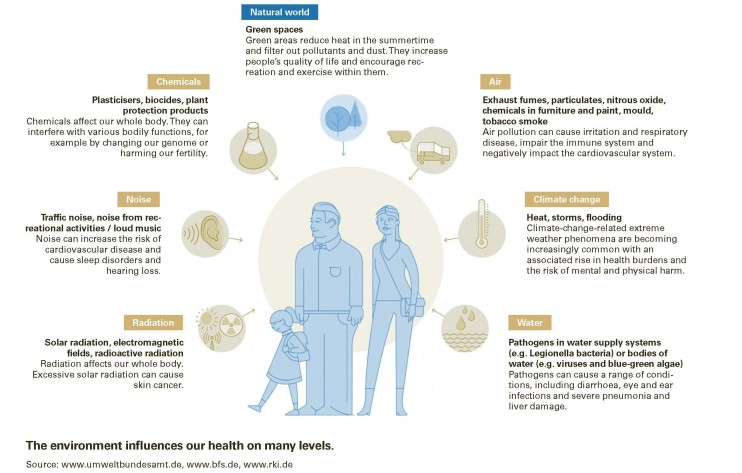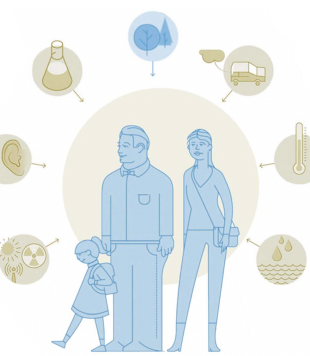
Environment and health: Viewing the system in its entirety
Sep. 2022Environment and health
Leitartikel. Climate change, air, noise, chemicals, drinking water and the natural world. Our health is affected by a large number of environmental variables, and there is a close link between the environment and human health. This edition of spectra shows just how close.
In 1854 there was an outbreak of cholera in the Soho district of London. At the time, people thought that this dreadful disease was caused by “bad air”. Unlike many of his colleagues, the British doctor John Snow was sceptical about this explanation. He went from door to door in Soho, asking local residents which pump they got their water from and if anyone in their house had caught cholera. By mapping cases, he was able to identify a pump in Broad Street as the possible cause of the outbreak and was successful in persuading the local council to disable the well pump by removing its handle. After that, the outbreak subsided. Although the germ theory of disease did not even exist at the time, Snow’s observations led him to conclude that cholera was transmitted not by bad air, but through drinking water.
The incident is not only regarded as the moment epidemiology was founded, it also shows just how big an impact the environment has always had on our health. Drinking water is just one of many environmental factors that are capable of having a negative – and positive – effect on our health. Other examples include chemicals, air, noise, radiation, climate change and the natural world (see diagram).
However, the example also highlights a further point: public health issues can only really be resolved by considering all the factors that are involved and thinking out of the box sometimes pays off. Since public health problems are often caused by factors outside the healthcare system, it is essential to look at the system in its entirety. This insight is as true today as it was then – as is the fact that health problems are still often only investigated within the boundaries of one specialist discipline.
Health maintenance strategies can no longer be restricted simply to humans and animals, but need to incorporate ecosystems to a greater extent.
Greater cooperation thanks to One Health
In recent decades, various strategies have been developed to promote this holistic approach, including Health in All Policies and the One Health approach. One Health is an integrative approach to partnership between human and veterinary medicine. There are plenty of recent examples to demonstrate the importance of the approach, such as the Ebola outbreaks in western Africa, the first SARS outbreak in 2002, the BSE (“mad cow disease”) crisis and the COVID-19 pandemic. The One Health approach is also being employed to address the antibiotic resistances that are circulating in humans, animals and the environment (see editorial).
With the effects of accelerating climate change on human health becoming ever more visible, efforts are currently under way to make the environment a more significant part of One Health. The environment is reacting to an increasing extent to problems caused by humanity, such as air pollution, global warming, changes in water cycles, species loss and declining soil fertility. Health maintenance strategies can no longer be restricted simply to humans and animals, but need to incorporate ecosystems to a greater extent. For this reason, various international organisations, including the FAO (Food and Agriculture Organization) and WHO, proposed a new definition in December 2021. “One Health is an integrated, unifying approach that aims to sustainably balance and optimize the health of people, animals and ecosystems.”

The environment influences our health on many levels. view graphic
Roadmap for Switzerland
Switzerland’s Federal Council has also recognised the urgency of the situation by including the environment as a major determinant of health in its 2030 health policy strategy. The aim is to promote health through the environment. In response, the Federal Office of Public Health (FOPH) and Federal Office for the Environment (FOEN) have drawn up a roadmap. This important instrument shows how the Federal Council will approach the implementation of its environmental- and health-strategy goals in the coming years.
The issues addressed by the roadmap cover the following four areas: “Climate change and loss of biodiversity”, “Pollutants, ionising radiation and noise”, “Health and
non-ionising radiation (electrical, magnetic and electromagnetic fields [EMFs], light,
UV light)”, and “Health-promoting natural and landscape attributes in the built environment”. The roadmap incorporates various measures (action plans, monitoring tasks, etc.) in each of these areas. FOEN and the FOPH are working with a large number of other partners to implement the roadmap.
Was ist «Planetary Health»?
Das Konzept von «Planetary Health», komplementär zu «One Health», fokussiert auf den Gesundheitszustand des Gesamt-Ökosystems, denn wenn wir unseren natürlichen Systemen schaden, schaden wir uns selbst. Der medizinische Grundsatz des «primum non nocere» wird hier auf unseren Planeten übertragen: Zunächst müssen wir sicherstellen, dass wir unserem Planeten nicht schaden.
Der Chefredaktor der medizinischen Fachzeitschrift «The Lancet», Richard Horton, schrieb bereits im Jahre 2014 zumThema «Planetary Health», dass die bisherigen Konzepte nicht mehr in der Lage seien, den Anforderungen, mit denen die Gesellschaften konfrontiert sind, wirklich gerecht zu werden, da sie zu eng gefasst seien, um einige dringende Herausforderungen zu erklären.
«Planetary Health» umfasst die Vorstellung, dass unsere Spezies innerhalb eines bestimmten Aktionsraums leben muss. Die Grenzen werden durch Gefahren wie etwa die Versauerung der Ozeane, den Abbau der Ozonschicht, den Verlust der biologischen Vielfalt oder den Klimawandel definiert. Wenn eine oder mehrere dieser Grenzen überschritten werden, könnte dies die planetaren Systeme so stark beeinträchtigen, dass das Überleben der menschlichen Spezies auf dem Spiel stünde. Fachpersonen zufolge sind bereits drei planetare Belastbarkeitsgrenzen überschritten – Klimawandel, biologische Vielfalt, globaler Stickstoffkreislauf.




